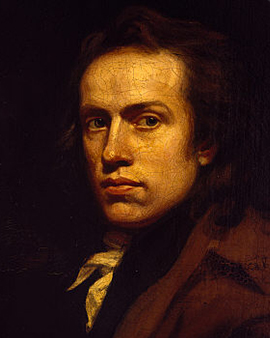Entering the captivating world of John Opie, one stumbles upon the narrative of an extraordinary life that ranged from rough Cornish art to painting the British royal family. Born in May 1761 in Trevellas, Cornwall, the youngest child of five siblings, Opie's talents were recognized early by none other than the satirical physician Dr. John Wolcot. Opie, who mastered Euclid's work with astonishing precision as well as teaching painting and mathematics, soon entered the world of professional painting under Wolcot's wing. The sawmill where he first worked was traded for the venerable study room, where Opie dipped his fingers in paint and honed his artistic skills. This thread of training eventually led him to London in 1781, where, under the tutelage of Wolcot, he put his considerable experience as a portraitist to work. The vibrant city became the focal point of his work, where he became acquainted with the who's who of the art scene, including Sir Joshua Reynolds. Opie's impressive career plays an essential role in the design of our art prints, as we always strive to do justice to his style and precision.
Opie's career was crowned with notable successes, including the creation of portraits for members of royalty, artists and literary figures. King George III purchased one of his paintings and commissioned a portrait of Mary Delany. His residence became the center of city society, where he created paintings for the Duchess and Duke of Gloucester, Lady Salisbury, Lady Charlotte Talbot, and other ladies of the court. His style, once created by a storm of enthusiasm, never went out of fashion. Instead of resting on his laurels, Opie continued to pursue the desire to improve his skills and expand his knowledge. Opie painted many notable figures, including Mary Wollstonecraft, Samuel Johnson, and Charles James Fox, to name a few. In all, he produced over 500 paintings, most of which were executed in oils and some in other techniques. Each of these showcases Opie's unique talent, which is carefully recreated in our fine art prints to fairly represent his style and precision.
In the later years of his career, Opie imparted his wisdom as a professor at the Royal Academy. His lectures were published posthumously as a book by his widow Amelie Opie, making his contribution to the art scene even more significant. Opie died in April 1807 and was buried in the crypt next to Joshua Reynolds in St. Paul's Cathedral, as he had wished. The vivid world of John Opie is reflected in each of his paintings. The diversity of his work will live on through our carefully reproduced art prints of Opie's paintings, capturing the essence of his art and expressing it in every detail of his works.
×





.jpg)
.jpg)
.jpg)
.jpg)
 Author of a Vindication of the Rights of Woman engraved by WT Annis pub 1802 - (MeisterDrucke-101588).jpg)
 Author of a Vindication of the Rights of Woman engraved by WT Annis pub 1802 - (MeisterDrucke-101588).jpg)
 Regiment Previously Called Colonel Dona - (MeisterDrucke-14170).jpg)
 Regiment Previously Called Colonel Dona - (MeisterDrucke-14170).jpg)
.jpg)
.jpg)
.jpg)
.jpg)
.jpg)
.jpg)
.jpg)
.jpg)
.jpg)
.jpg)
.jpg)
.jpg)
.jpg)
.jpg)
.jpg)
.jpg)
.jpg)
.jpg)
.jpg)
.jpg)
.jpg)
.jpg)
.jpg)
.jpg)
_-_(MeisterDrucke-1114021).jpg)
_-_(MeisterDrucke-1114021).jpg)
.jpg)
.jpg)
.jpg)
.jpg)
_-_(MeisterDrucke-560415).jpg)
_-_(MeisterDrucke-560415).jpg)
.jpg)
.jpg)
.jpg)
.jpg)
_-_(MeisterDrucke-1093108).jpg)
_-_(MeisterDrucke-1093108).jpg)
_-_(MeisterDrucke-1099337).jpg)
_-_(MeisterDrucke-1099337).jpg)
.jpg)
.jpg)
.jpg)
.jpg)
.jpg)
.jpg)
.jpg)
.jpg)
_-_(MeisterDrucke-1554002).jpg)
_-_(MeisterDrucke-1554002).jpg)
.jpg)
.jpg)
_-_(MeisterDrucke-979779).jpg)
_-_(MeisterDrucke-979779).jpg)
.jpg)
.jpg)
.jpg)
.jpg)
.jpg)
.jpg)
_-_(MeisterDrucke-38024).jpg)
_-_(MeisterDrucke-38024).jpg)
.jpg)
.jpg)
.jpg)
.jpg)
.jpg)
.jpg)
_-_(MeisterDrucke-979818).jpg)
_-_(MeisterDrucke-979818).jpg)
.jpg)
.jpg)
.jpg)
.jpg)
.jpg)
.jpg)
_Regiment_Previously_-_(MeisterDrucke-1573689).jpg)
_Regiment_Previously_-_(MeisterDrucke-1573689).jpg)
.jpg)
.jpg)
.jpg)
.jpg)
.jpg)
.jpg)
.jpg)
.jpg)
.jpg)
.jpg)
.jpg)
.jpg)
 c1822 - (MeisterDrucke-243030).jpg)
 c1822 - (MeisterDrucke-243030).jpg)
.jpg)
.jpg)
.jpg)
.jpg)
.jpg)
.jpg)
.jpg)
.jpg)
 1787 (mezzotint engraving) - (MeisterDrucke-69375).jpg)
 1787 (mezzotint engraving) - (MeisterDrucke-69375).jpg)
.jpg)
.jpg)
.jpg)
.jpg)
.jpg)
.jpg)
.jpg)
.jpg)
.jpg)
.jpg)
_(1779-1852)_by_Opie_John_(1761-1807)_O_-_(MeisterDrucke-941540).jpg)
_(1779-1852)_by_Opie_John_(1761-1807)_O_-_(MeisterDrucke-941540).jpg)
.jpg)
.jpg)
 - (MeisterDrucke-290787).jpg)
 - (MeisterDrucke-290787).jpg)
.jpg)
.jpg)
.jpg)
.jpg)
.jpg)
.jpg)
.jpg)
.jpg)
_-_(MeisterDrucke-1642328).jpg)
_-_(MeisterDrucke-1642328).jpg)
.jpg)
.jpg)






